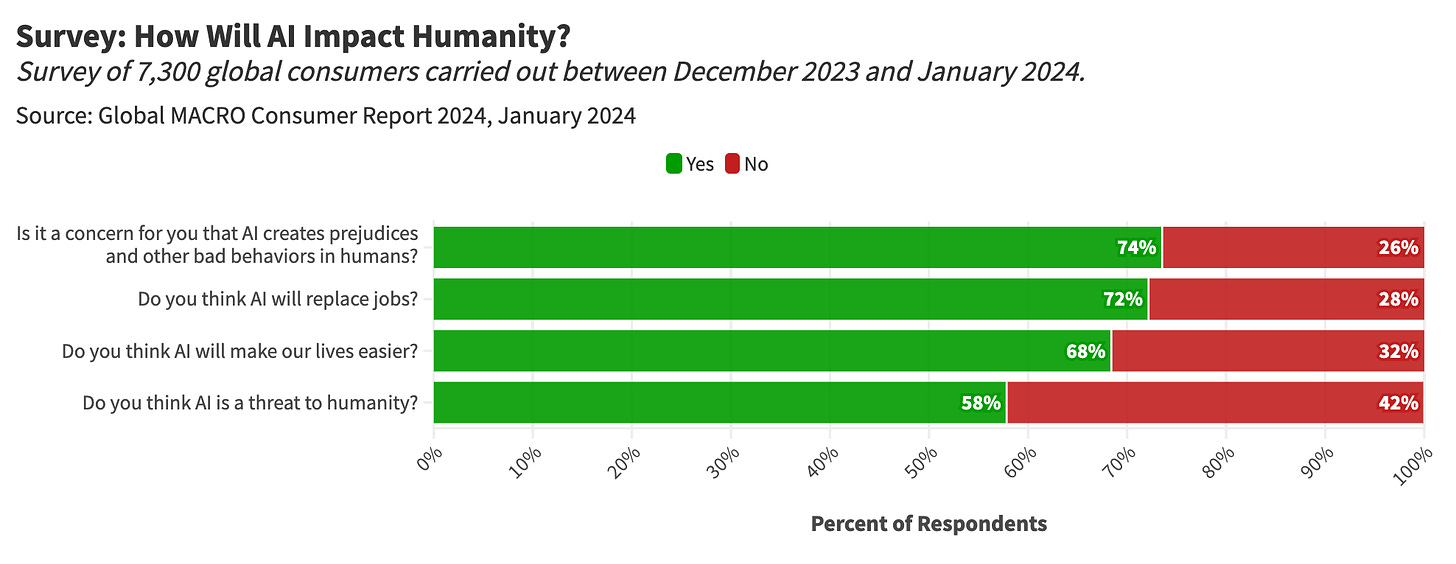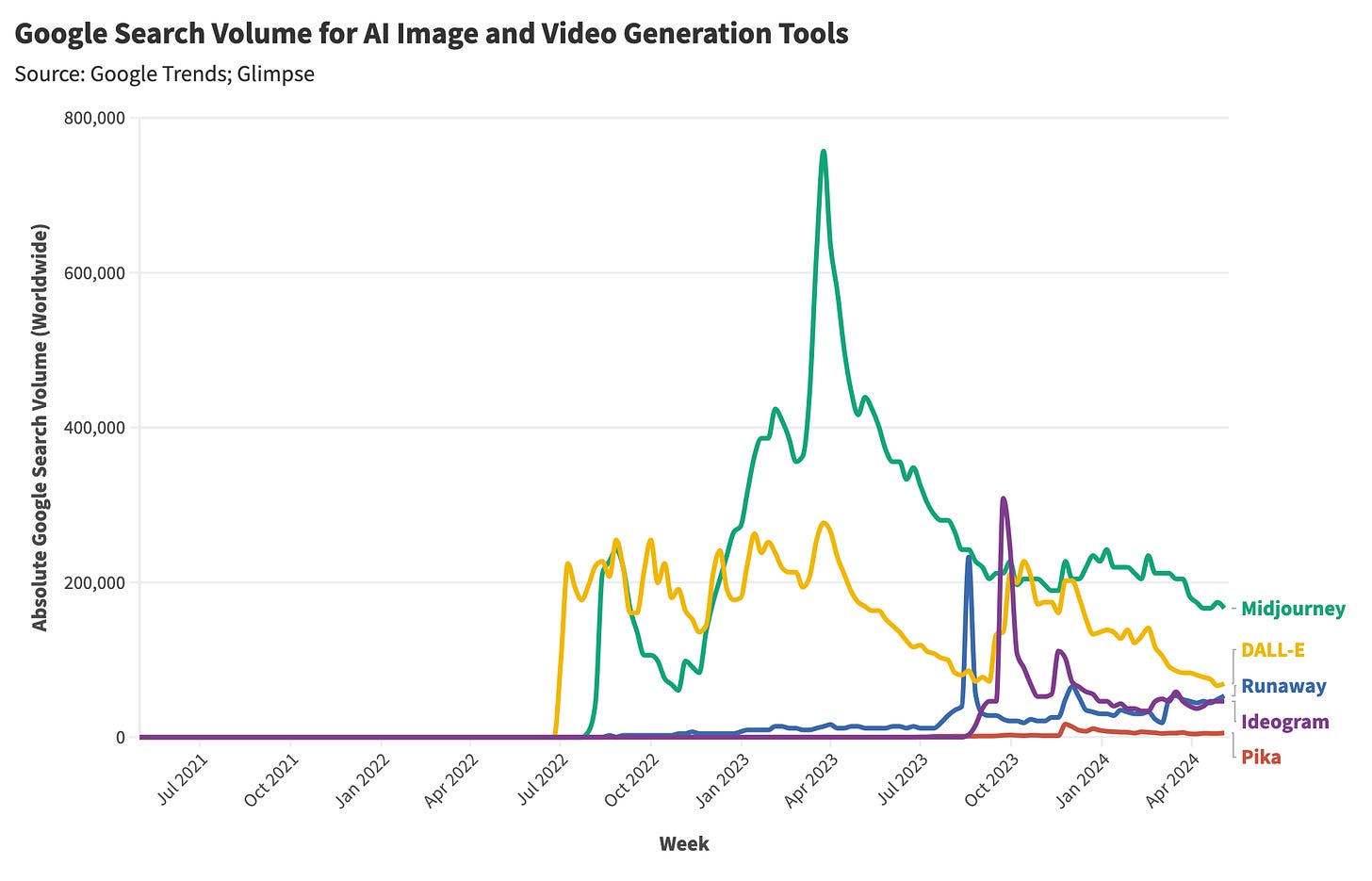Weekly writing about how technology and people intersect. By day, I’m building Daybreak to partner with early-stage founders. By night, I’m writing Digital Native about market trends and startup opportunities.
If you haven’t subscribed, join 60,000 weekly readers by subscribing here:
Where Does AI Go From Here?
The best outfit at Monday’s Met Gala was…AI?
Katy Perry tricked fans into thinking she walked the Met Gala red carpet. On Instagram, she showed off her “look,” even managing to convince her own mother that she attended the event.
AI is decidedly mainstream; the genie is out of the bottle.
It’s now been 18 months since ChatGPT launched. ChatGPT came out of the gate as the fastest-growing application in history—five days to 1M users, two months to 100M. (For context, TikTok took nine months to hit 100M and Instagram took 2.5 years.) And ChatGPT has largely maintained that momentum, though Meta’s Threads broke its record by amassing 1M users in under an hour and 100M in under a week.
Here’s a look at website traffic for the most popular AI tools, with ChatGPT leading the way:

A few takeaways from this chart:
1.8B visits is mighty impressive,
Other tools—primarily Google’s Gemini—are catching up, and
We’re still very early days.
I’ve been thinking a lot about AI adoption—where we sit today and where we’re headed. We’re undoubtedly in a hype cycle, but we’re also seeing speed of technology adoption the likes of which we haven’t seen in years. My friend Daniel Parris writes the terrific Stat Significant about pop culture (check it out here) and is a talented data visualizer; after we chatted last week, he shared some interesting graphics he put together on AI adoption.
Building on the graphic above, here’s a better look at how Gemini is catching up to ChatGPT. From March 2023 to March 2024, Gemini roared from 30M monthly visits to 434M. ChatGPT’s growth, meanwhile, has slowed.

This graphic captures a hard truth: built-in distribution, like Google’s, is tough to beat. More on that topic later.
Another revealing graphic shows that despite the eye-popping numbers above, we’re still very, very early. Below is a visual of web traffic across the internet—the top sites are 1) Google, the winner in Search with 85.4B monthly visits; 2) YouTube, the winner in video with 32.4B monthly visits; and 3) Facebook, the winner in social with 16B monthly visits.
The tiny purple bubble on the bottom left comprises AI tools; again, early days.

AI adoption is the story of the decade. This week’s Digital Native aims to answer the questions of where we are today and where we’re heading. I’ve broken the piece into three main parts. The first part uses graphics from Daniel and from Stanford’s new AI report to look at where we stand today; the second and third parts delve into what I think comes next.
State of the Union: AI Tool Adoption
What’s Next: The Age of the Agents
Pricing, Distribution, and Use Cases
Let’s dive in.
State of the Union: AI Tool Adoption
Last week, Stanford released its annual AI report. The report included this chart, which shows AI performance against human benchmarks:

The slope of those lines is steep; we’ve come a long way since 2020.
The only categories that remain below human baselines are 1) competition-level mathematics and 2) multitask language understanding (two categories in which I also fall short of baseline).
Here’s a look at training compute for major machine learning models. Google’s Gemini Ultra, Open-AI’s GPT-4, Anthropic’s Claude 2, and Meta’s Llama 2-70B lead the way. Note that the scale is logarithmic; AI is improving at an exponential rate. As Sam Altman said to a group of Stanford students last week, “GPT-4 is the dumbest model any of you will ever use.”

Technology has a long history of augmenting human ability, and the results for generative AI have been impressive. A Harvard Business School study showed that consultants with access to GPT-4 increased productivity on a selection of consulting tasks by 12.2%, speed by 25.1%, and quality by 40.0%, compared to a control group without AI access.
Here’s a visual of that study from the Stanford AI report:

Other studies have had similar findings. A study from the National Bureau of Economic Research, for instance, found that callcenter agents using AI handled 14.2% more calls per hour than those not using AI. No surprise there.
Here’s a visual from Daniel on what share of U.S. adults have ever used ChatGPT:

Even among the core “early adopter” demographic of 18- to 29-year-olds, we’re still under 50%. Among those that have used ChatGPT, use cases vary across work, learning, and entertainment:

Many people have either never used AI, or aren’t even sure whether they have:

Usage is often non-occurrent, or when it does happen, infrequent:

And AI still lags behind the internet and mobile as “revolutionary” in the eyes of consumers. I expect that in 10 years, AI is on par with the internet here.

We clearly need new tools to push generative AI to become a daily use case and to further revolutionize our lives; those tools are coming, and more on that topic in a bit.
One more interesting dataset to track: consumer sentiment around AI. The media has a long history of painting AI as dangerous—a threat to humanity. Daniel shared with me some media history: back in 1920, the Czech writer Karel Čapek wrote a play called “R.U.R.”—Rossum’s Universal Robots. The play introduced the word robot, a descendant of the Czech word “robota,” which means forced labor. The play tells the story of a factory that makes artificial humans called robots, who are built to serve mankind but—shocker—ultimately gain consciously and revolt, leading to the extinction of the human race.
“R.U.R” began a long line of dystopian AI stories. Some of the most famous villains in film history are AI—Hal 9000 from 2001: A Space Odyssey and The Terminator from, well, The Terminator come to mind. It’s no wonder people are afraid of AI.
A survey of 7,300 global consumers by research firm MACRO showed widespread fears that AI systems will spur job loss, extinction, and social discord:

People think AI will make our lives easier, sure, but that belief comes amidst a lot of hand-wringing, anxiety, and uncertainty. We’re seeing a sharp increase in AI skepticism and fear:

Concern stems from AI being a black box to most of us:

At the Berkshire Hathaway shareholder meeting this week, Warren Buffett sounded alarm bells for AI deepfakes. After Buffett saw a convincing deepfake of himself, he remarked:
“I mean, scamming has always been part of the American scene but it’s going to be the growth industry of all time…Obviously, AI has potential for good things too but…based on the [deepfake] I saw recently, I practically would send money to myself over and over in some crazy country.”
He went on to compare AI to the advent of the atomic bomb and nuclear weaponry—inevitable, but terrifying:
“We let a genie out of the bottle when we developed nuclear weapons and that genie has been doing some terrible things lately, and the power of that genie is what scares the hell out of me. And on the other hand, I don’t know any way to get the genie back in the bottle. It’s partway out of the bottle, and it’s enormously important, and it’s going to be done by somebody.”
What’s Next: The Age of Agents
It’s clear we’re entering the age of AI agents.
I think of a simple example. Say you run a small business, maybe a mom-and-pop hardware shop. A big part of your job is ordering supplies and managing inventory.
In the old days, you did this via pen-and-paper and phone calls. You called the supplier and said, “Hey Steve, I’m running low on screwdrivers—can I order 100 more for May?” Then you wrote it down on a clipboard (Steve did the same on his end) and you waited for the shipment to arrive. Maybe you had to call Steve to check on its timing. You probably sent him a check to pay for it.
In the age of software, this moved online. You realized you were running low on screwdrivers, and you opened some nifty vertical software product purpose-built for small businesses. You entered your order into a dashboard, and you paid digitally, all within the same portal.
Now, we’re entering a new era—an era in which software doesn’t just digitize the analog process, but in which software agents execute the workflow for you. In this new era, you don’t have to do anything at all; an AI agent trained on your business realizes that you’re low on screwdrivers and automatically places the order for you, before you even think about it. It’s like having a new employee, carrying out all your thankless tasks.
In 2024, the AI agent craze is entering full-force in the early-stage markets. But we should give Bill Gates more credit for foreseeing it years ago.
Back in 2017, before Microsoft had begun to partner with OpenAI, Gates shared a memo with Microsoft top executives, including CEO Satya Nadella. That memo predicted a forthcoming world order of “AI agents,” digital personal assistants that would anticipate our needs and wants. According to an Insider story, the memo read:
“Agents are not only going to change how everyone interacts with computers. They’re also going to upend the software industry, bringing about the biggest revolution in computing since we went from typing commands to tapping on icons.”
That wasn’t the first time Gates made such a prediction. Back in his 1995 book The Road Ahead, he’d predicted a world in which we would navigate the internet through software that would “have a personality you’ll be able to talk to” and that would “learn about your requirements and preferences in much the way that a human assistant does.”
Today, of course, Gates’s predictions look at a lot like Copilot, the AI tool that Microsoft has embedded into its products. One Seeking Alpha report estimates that Copilot will add $56B to Microsoft’s revenue by 2028, good for ~12% of sales. Microsoft’s AI prescience should power its continued rein as the world’s most-valuable company ($3.1T), ahead of Apple, which seemingly has no plan for AI and is beleaguered by poor iPhone sales.
So, credit to Bill Gates. We’re now firmly in “The Age of the Agent” and companies are testing business models, distribution channels, and use cases for this new era.
Pricing, Distribution, and Use Cases
Most of us learned to use ChatGPT for fun. Maybe we asked ChatGPT to write a haiku about Joe Biden. My friend has a test question he uses on all chatbots to test their accuracy: “List every month of the year and for each month, list all Taylor Swift songs that mention that month.” So far Gemini comes closest to getting it right, but no tool has nailed the challenge. (Makes me less worried about AI taking over the world.)
But companies have learned that LLMs can do a lot more than write haikus and name pop songs, and they’re willing to pay for those capabilities. We’re seeing a shift to enterprise use cases and, consequently, an increase in pricing.
OpenAI rolled out ChatGPT Enterprise last August, charging $60 per seat. Perplexity charges Pro customers $40 per month, or $400 per year, for each employee. Wired ran a piece this week about how Tome, the AI presentation software, is pivoting to enterprise from prosumer. Compute is expensive; these companies aren’t cheap to operate.
We also see innovation in pricing. For Cognition, “minutes worked” is a metric that Devin—Cognition’s “AI software engineer”—shares with users. AI companies may sell their software as work completed rather than with traditional SaaS pricing. If the average software engineer costs you $100K+, but Devin renders her moot, then that’s a pretty lucrative pricing strategy. The HBS study earlier showed that AI makes consultants 40% more productive; should the tool be priced at 40% of a consultant’s salary?
Challenges for AI upstarts are 1) distribution, and 2) defensibility. To return to the visual earlier, Gemini is catching up to ChatGPT:
How might this look in a few years? Distribution is a powerful thing.
How can AI productivity tools compete with the might of Microsoft Office or Google Workspace? Or even with Notion, with some people saying Notion AI is already adding $100M+ in net-new ARR to Notion? If your product is an API call to OpenAI, you aren’t defensible; the incumbent with existing distribution will probably win.
More interesting are the net-new use cases for AI. Character has 3.5M users who spend an average of two hours a day (!) on Character. A couple years back, we definitely weren’t spending hours talking to chatbots. In enterprise, take Sierra, the new company from former Salesforce co-CEO Bret Taylor, which is building agents for businesses. Sure, incumbents (including Salesforce) have launched agents, but those enterprises aren’t laser-focused on the new functionality of conversational AI.
What I think is most interesting: how do AI tools expand human capabilities?
What does that even mean? I like the example given by Alyssa Henry on the No Priors podcast. Before Microsoft Word, only secretaries used word processors; Word was initially written off as niche. Of course, now everyone uses a word processor. An intuitive, affordable tool expanded the userbase.
AI tools do something similar. I’m by no means a graphic designer, but I can use Midjourney to whip up cover art for this piece in seconds:
Of course, products still need to innovate and layer on new functionality to retain users and expand a market. Search volume and Glimpse data seem to show that Midjourney interest peaked in summer 2023; sustaining momentum is tough.

But the right tool unleashes latent demand.
Jeffrey Katzenberg, one of the founders of Dreamworks, spoke recently about AI’s impact on animation. Today, according to Katzenberg, a Dreamworks film requires 500 animators, five years of production, and $150-200M in budget. Within a couple years, he expects that requirement to drop to 50 animators, six months, and $15M.
Hundreds of studios will be able to produce their own Shrek, not the handful of entertainment giants. Eventually, production costs will drop another order of magnitude, crowding in an army of creators. We’ll all be Dreamworks animators, graphic designers, haiku writers, and more.
Sources & Additional Reading
Stat Significant by Daniel Parrish — Daniel put together the great data visualizations in this piece, and his publication on pop culture is one of my favorites
How AI Can Help Small Businesses | Alyssa Henry on No Priors Podcast
Bill Gates Is Still Pulling the Strings at Microsoft | Insider
Gen AI Hype vs. Reality is a good guest piece Daniel wrote for Data-Driven VC, that covers some of the AI adoption charts and commentary in Part I of this piece.
Related Digital Native Pieces
Thanks for reading! Subscribe here to receive Digital Native in your inbox each week:










